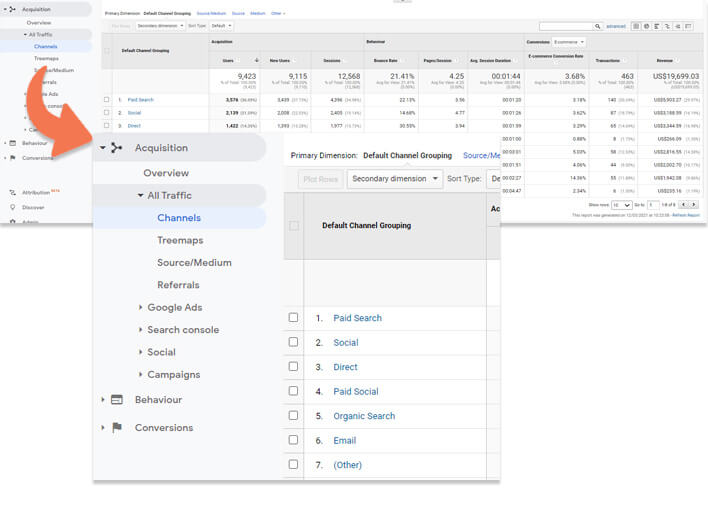Breaking Down your Traffic Sources

Building an effective online presence requires a multitude of traffic sources.
Obviously your traffic plays a major part as to whether you are successful or not, so it is good to get a grip on where that traffic is coming from.
Most of us rely on Google Analytics for our traffic reports.
Google allows you to see various acquistion channels. Which is a good thing….
But where do you find this data and what does it mean?
Good question….
Start by logging in to your analytics console.
Navigate to Acquisitons> All Traffic > Channels

You will see there are a few categories which comprise the total traffic to your site (or at least Google’s understanding of the total traffic) called Channel Groups or Channels.
Google Analytics makes a fairly good attempt to identify where the traffic came from – ie its source
And then to assign them useful labels – such as direct, organic search, paid search, referral, and social – which can then be further examined.
Looking at these channels more closely can be valuable for gaining insight as to how people are finding you and where best to focus your marketing efforts (and money).
Let’s look at them each in turn
A word of caution here – these stats are generally quite accurate. But use them a guide rather than an absolute source of truth!
I have managed SEO on many eCommerce sites where the stats from Analytics, Facebook and the actual sales made via the site dont exactly agree each other.
At the end of the day Analytics is just a tool – be aware of its limitations and you will be fine.
Direct Traffic
Direct traffic is traffic which does not come from website referrals ie is direct to you and not via somewhere else
Instead, they come from unique, often unknown sources that directly access your content.
Some examples of this might be when someone types or pastes in your URL to visit your site directly, clicks a bookmark that they have saved, or otherwise ends up on your website by clicking a link that Google Analytics can’t see.
Email Traffic
Email traffic is produced when you properly tag your email campaigns with email parameters. And then someone clicks on the link in your email to visit your site.
(it has to be tagged, otherwise it might end up recorded as Direct Traffic)
Organic Traffic
This one is slighly easily understood.
This is traffic that comes to your site from unpaid search engine queries ie not paid ads and not social media.
It typically results from your inbound marketing and SEO efforts.
In other words someone went to Google, did a search , saw your listing and clicked on it!
When they arrived at your site their visit is an organic one.
So that time and effort spent on SEO should see an increase in Organic Traffic (and probably direct traffic as well)
Where Analytics can be frustrating is that getting a breakdown of what they actually typed into the search box before they got to your site!
Often the majority of the organic traffic data is tagged as “(not provided)”
Which means Google don’t know what the search phrase was
This forces us to then go over to Google Search Console to find the data there!
So really Google does know the data! Thanks for keeping it simple (not), Google…..
The only saving grace here is that you can link Search Console and Analytics together
Which allows you to access the Search Console data from the Analytics dashboard.
Rather than swapping out of one into the other …
Paid Search Traffic
Most people think of Google Ads here
The Paid Search channel in Google Analytics however comprises all of the traffic sources bringing visits to your site that are attributed as CPC, PPC, or paid search.
This may include paid traffic sources outside of Google, Bing and Yahoo!.
This traffic channel report generally shows how much total paid traffic you have received.
But .. it doesnt include paid social media traffic!!
Ie FB or instagram ad traffic is not part of this
It is defintely possible to measure Social Media ads traffic – it just requires a bit of a work around (which is beyond the scope of this simple post!)
Social Traffic
By this we mean traffic from Instagram, Facebook, Twitter, LinkedIn, TikTok, and so on.
The kind of traffic these sites produce is known as social traffic.
As noted above ypu may have to do a bit of extra preparation to know whether the social media traffic reported came from an organic post or a paid ad.
Referral Traffic
This is when individuals click on hyperlinks on other websites, such as an article you posted on someone elses site
Or a directory site
This would not include traffic from social media platforms or search engines.
Conversion Tracking
Once you have got your head around where the traffic is coming from the next logical question is
“What does this traffic it do once it gets to my site?”
That falls under the subject of conversion tracking and is a joyful subject which I will cover in another post at another time.
For now we are just looking at how people got to your site in the first place.
Among all these traffic sources, direct and organic traffic are the two most relevant to SEO.
SEO should increase both of them.
And that is what I always aim for with my SEO customers.
I would invite you to download the free eBook available on this website.. it has a fairly extensive section on setting up Google Analytics and Google Search Console.
